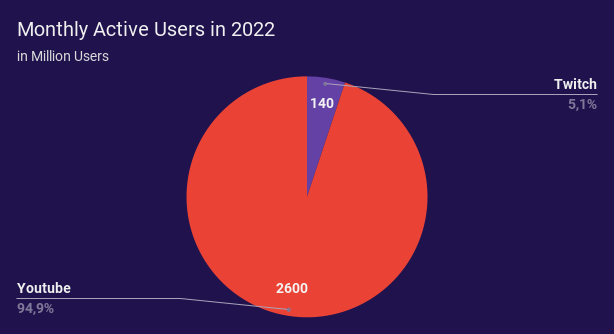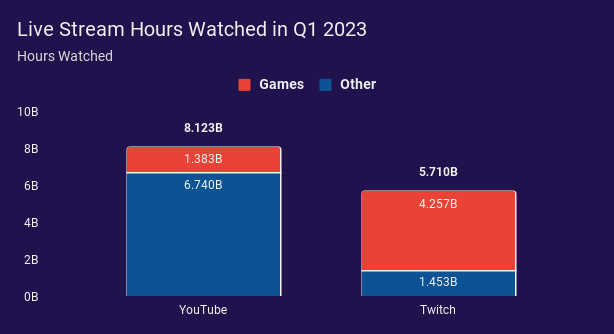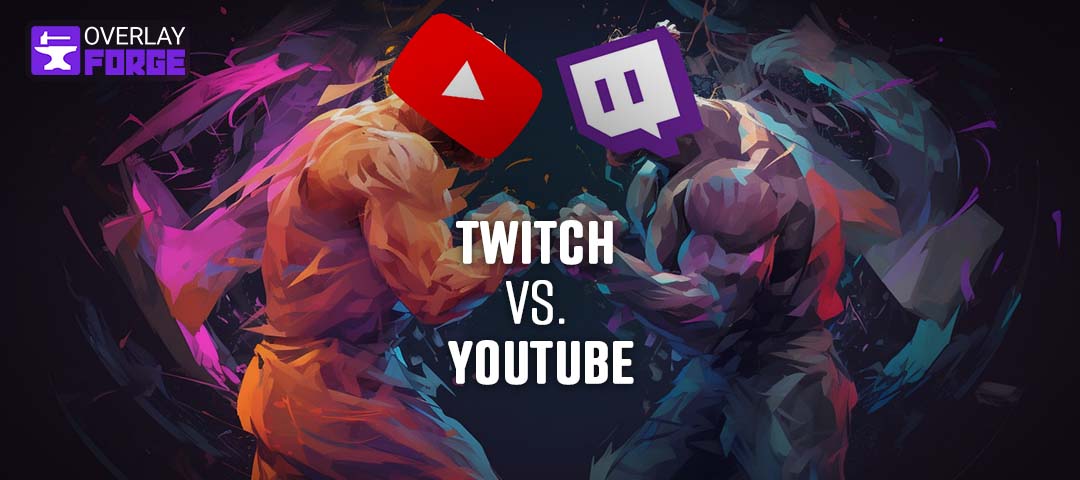Hey there, future streamer! So, you’ve decided to launch on an exciting journey but are still deciding whether to choose Twitch or YouTube, right? Don’t sweat it! This blog post will discuss the differences between these two popular platforms and compare the details, so lean back and enjoy the ride. And in the end, you will know which platform fits you the best.
Twitch and YouTube have seen some awe-inspiring growth and popularity recently. Here are some quick stats to get us started:
YouTube:
- Over 2.5 billion monthly active users (that’s a lot of potential viewers!)
- A whopping 500 hours of video uploaded every single minute
- 70% of watch time comes from mobile devices (everyone’s watching on-the-go!)
- Ranked second most popular social media platform
Twitch:
- 11 million+ people decided to give streaming a shot for the first time in 2022 (you’re in good company!)
- An astounding 1.3 trillion minutes watched in 2022
- 31 million daily visitors on average (talk about traffic!)
- 7 million unique streamers going live each month
- Live content being broadcast in 35 languages (diversity at its finest)
Now that you’ve got an overview of each platform’s facts, let’s look at some features and opportunities both offer. By this blog post’s end, you’ll know exactly which platform is the perfect fit for your streaming dreams. Let’s get started!
Comparing Twitch and YouTube as Streaming Platforms

Twitch and YouTube have emerged as the top dogs in the streaming universe, each with a unique focus and audience demographics. Understanding the basics will help you decide which platform will best suit your streaming ambitions.
Twitch Overview
Twitch is a popular live streaming platform primarily focused on gaming and esports. It has a clean and easy to use interface and is all about the community of gamers, streamers, and viewers. The platform has expanded to include other content categories such as IRL (in real life) streams, creative channels, and music. Twitch’s interactive features, like chat and emotes, encourage engagement and help build strong connections between streamers and their audience.
YouTube Overview
YouTube is a titan in the online video space with a massive amount of content beyond just live streaming. While YouTube has made strides to cater to the streaming community, its focus remains on pre-recorded videos. YouTube’s diverse content and massive user base will give you a huge range of viewers with many interests, making it a top choice for content creators looking to reach a broader audience.
In conclusion, both Twitch and YouTube offer unique opportunities for streamers to connect with their audience and showcase their content. Twitch excels in live streaming and gaming, with a strong focus on community engagement and interactive features. On the other hand, YouTube boasts a massive user base, diverse content, and a more extensive reach, catering to a wider range of interests beyond live streaming.
Choosing the Right Platform for Your Personality Type
When selecting a streaming platform, the choice between Twitch and YouTube is more than just about features, monetization, and audience demographics. Your personality type and content style also play a crucial role in determining which platform suits you best. This section will explore how different personality types may thrive on Twitch or YouTube.
The Extroverted Social Butterfly: Twitch
Suppose you’re a natural conversationalist who loves engaging with others and growing a close-knit community. Then, Twitch might be the perfect platform for you. Twitch’s real-time interaction through chat allows extroverted streamers to connect with their audience personally, fostering a sense of friendship and community.
As an extroverted social butterfly, you’ll excel at spontaneous conversations, reacting to your viewers’ input, and maintaining an entertaining atmosphere throughout your live streams. This personality type is well-suited for Twitch, where direct engagement with your audience is the cornerstone of the platform.
The Creative Storyteller: YouTube
For those who enjoy crafting stories, planning, and editing content, YouTube offers a platform that supports live streaming and pre-recorded videos. This flexibility allows you to take your time and perfect your narrative, whether creating an instructional video, sharing your experiences, or showcasing your talents.
As a creative storyteller, you’ll appreciate YouTube’s tools and resources for optimizing your content, such as video editing options, SEO, and in-depth analytics. This personality type is ideal for YouTube, where carefully crafted content and storytelling can help you connect with a broader audience and establish a robust online presence.
The Versatile Hybrid: Both Platforms
When you identify with the extroverted social butterfly and the creative storyteller, consider using Twitch and YouTube to showcase your talents. By live streaming on Twitch and repurposing edited content for YouTube, you can enjoy the best of both worlds, engaging with your audience in real time and reaching a larger, more diverse audience through curated video uploads.
By understanding your strengths and preferences, you can choose the platform that allows your unique personality to shine and helps you reach your streaming goals.
Monetization Opportunities on Twitch and YouTube
As you begin to lay the groundwork for your streaming career, understanding monetization opportunities is crucial for long-term success. Both Twitch and YouTube offer a variety of ways to generate income from your content. In this section, we’ll explore the different monetization options available and compare their earning potential for new streamers.
Twitch Monetization
Twitch presents several attractive options for monetization, making it a popular choice for streamers aiming to make a living from their content. As streamers reach the Affiliate or Partner level, they unlock access to additional monetization features, further enhancing the platform’s appeal.
Twitch Affiliate Requirements
To qualify for Twitch’s Affiliate program, streamers must meet the following requirements:
At least 500 total minutes of broadcast over the past 30 days
7 unique broadcast days in the past 30 days
An average of 3 or more concurrent viewers over the past 30 days
At least 50 followers
Twitch Partner Requirements
To become a Twitch Partner, streamers need to meet these requirements:
Stream for 25 hours over the past 30 days
Stream on 12 different days in the past 30 days
Have an average of 75 or more concurrent viewers over the past 30 days
Some of the primary ways to earn money on Twitch include:
- Subscriptions: Viewers can support their favorite streamers by subscribing to their channels. Streamers typically earn a percentage of the subscription revenue.
- Ads: Streamers can generate revenue by running ads during their streams once they become Twitch Affiliates or Partners.
- Bits: Twitch’s virtual currency, Bits, enables viewers to show their support by “cheering” for the streamer. Streamers receive a portion of the revenue generated from Bits.
- Donations: Another way streamers can earn money on Twitch is to set up direct donations.
YouTube Monetization
For streamers who become part of the YouTube Partner Program, YouTube offers several opportunities to generate income from their content.
YouTube Partner Requirements
To become a YouTube Partner, streamers must meet specific eligibility criteria, which include:
At least 1,000 subscribers
4,000 watch hours in the past 12 months
OR
At least 1,000 subscribers
10 million Shorts views in the past 90 days
These monetization options include:
- Ads: Once approved as a YouTube Partner, streamers can monetize their videos and live streams by displaying ads on their content, earning revenue in the process.
- Super Chats: During live streams, viewers can purchase Super Chats to highlight their messages in the chat, with a portion of the revenue going to the streamer.
- Channel Memberships: As a YouTube Partner, streamers can offer channel memberships, similar to Twitch subscriptions. Viewers can support streamers by becoming channel members, with membership tiers and perks determined by the streamer.
- Merchandise Shelf: YouTube Partners can sell their merchandise directly through the platform with the Merchandise Shelf feature, which showcases products below the video player.
Both platforms offer numerous monetization options, but the earning potential for new streamers will depend on their content, audience, and ability to engage viewers. By leveraging the monetization opportunities available on your chosen platform, you can work toward turning your streaming passion into a sustainable profession.
Twitch Features vs. YouTube Features
Before selecting a streaming platform, it’s essential to compare the core features of both Twitch and YouTube. In this section, we will do just that and take and discuss their importance for content creators.
Live Streaming Capabilities
Twitch and YouTube both provide robust live streaming capabilities. However, Twitch primarily concentrates on live content, while YouTube maintains a more balanced approach between live and pre-recorded content. This focus on live streaming gives Twitch an edge in real-time interaction and chat features, whereas YouTube’s strength lies in its seamless integration of live and pre-recorded content.

Chat and Community Interaction
Twitch’s chat system is renowned for its extensive range of emotes and custom chat features, offering a more engaging and interactive experience for viewers. YouTube also has a chat system, but it lacks the same level of customization and interactivity found on Twitch. For content creators looking to foster strong communities and viewer engagement, Twitch may be a more attractive option.
Content Discoverability
Regarding Discoverability, YouTube has a significant advantage, especially for new content creators. Its advanced search algorithms make it very easy for viewers to discover new content and new creators alike. Conversely, Twitch relies on the user’s browsing habits and direct referrals, making it challenging for new streamers to get noticed.
Video Storage and Organization
YouTube excels in video storage and organization, allowing content creators to upload, categorize, and create playlists of their videos. This feature makes it easy for viewers to access past content and helps creators build a more extensive video library over time. While Twitch does offer video storage through its Video on Demand (VOD) system, it is more limited compared to YouTube, and VODs are automatically deleted after a certain period for non-partners.
Analytics and Performance Tracking
YouTube provides comprehensive analytics, empowering content creators to track their performance, identify trends, and optimize their content based on data-driven insights. Twitch also offers analytics, but they are generally considered less detailed than YouTube’s. For content creators seeking to make data-informed decisions, YouTube may be the superior choice.
In conclusion, Twitch and YouTube have unique features catering to content creators’ needs. When selecting a platform, it’s crucial to consider which features align with your content strategy and personal preferences and the type of audience you aim to attract.
Pros and Cons of Twitch and YouTube for New Streamers
Selecting the right platform for your streaming journey is vital for success. To aid you in making an informed decision, let’s weigh the advantages and disadvantages of Twitch and YouTube for novice streamers.
Twitch
Pros of Twitch
Twitch offers several benefits for new streamers, including:
- Robust gaming community: With a dedicated gaming community, Twitch is an ideal match for those intending to stream video games or connect with gamers.
- Real-time interaction: Focused on live streaming, Twitch facilitates direct and immediate communication between streamers and viewers, fostering a sense of community and engagement.
- Platform-specific features: Unique features such as emotes, raids, and clips on Twitch can enhance the streaming experience and contribute to building a loyal audience.
Cons of Twitch
Conversely, Twitch presents some challenges for new streamers:
- Niche focus: Twitch’s primary emphasis on gaming may restrict its appeal for those interested in streaming non-gaming content.
- Saturation: With numerous established streamers on the platform, it can be difficult for newcomers to stand out and attract attention.
YouTube
Pros of YouTube
Several benefits come with using YouTube for new creators:
- Wider audience reach: YouTube’s vast user base and diverse content afford the potential to connect with a broader audience.
- Enhanced search functionality: YouTube’s sophisticated algorithm simplifies content discovery for viewers based on their interests.
- Versatility: Supporting both live streaming and pre-recorded videos, YouTube provides flexibility in content creation and audience engagement.
Cons of YouTube
However, YouTube has some drawbacks for new streamers:
- Increased competition: The abundance of content on YouTube translates to heightened competition for viewers’ attention.
- Less focus on live streaming: As YouTube primarily centers on pre-recorded videos, its live streaming features might not be as advanced or comprehensive as those on Twitch.
When evaluating the pros and cons of each platform, consider your content focus and personal preferences to determine the most suitable platform for your needs.
Conclusion and Recommendations
In conclusion, Twitch and YouTube offer unique opportunities and challenges for new streamers looking to start their journey. While Twitch has a strong gaming community and real-time interaction, it can be challenging to stand out among the competition. YouTube, on the other hand, has a broader audience reach and better search functionality, but its primary focus on pre-recorded videos means live streaming features may be less advanced.
For new streamers looking to grow quickly and start earning their first bucks, YouTube might be the better option. Its search functionality, combined with the potential for a larger and more diverse audience, can make gaining visibility and attracting viewers easier. Additionally, the platform’s versatility in supporting live streaming and pre-recorded content allows for extraordinary content creation and monetization flexibility.
That being said, it’s essential to consider your personal goals, preferences, and the type of content you plan to create. No matter which platform you choose, focus on creating engaging content, connecting with your audience, and utilizing the unique features and tools each platform offers to maximize your chances of success. And remember, it’s not uncommon for streamers to use both platforms to expand their reach and diversify their content.
FAQ
There is no definitive answer as it depends on your goals, content, and target audience. Twitch is better for live streaming, especially gaming, and building a dedicated community. YouTube is better for a wider range of content, reaching a larger audience, and combining video uploads with live streaming.
It varies depending on the individual creator’s success and monetization strategies. Some Twitch streamers make more than YouTubers, while others make less. Both platforms offer different monetization options, and success depends on factors like audience size, engagement, and content quality.
The best platform to stream on depends on your content focus, audience, and monetization goals. Twitch is ideal for live streaming, especially gaming, and building a close-knit community. YouTube is suitable for a broader range of content, reaching a larger audience and offering video uploads alongside live streaming.
Twitch initially focused on gaming but has expanded to include other categories like music, art, and “Just Chatting.” While gaming remains the primary focus, Twitch now accommodates various content types.
The platform that pays the most for streams depends on your audience size, engagement, and monetization strategies. Both Twitch and YouTube offer different monetization options, such as subscriptions, ads, and donations. The potential earnings vary based on individual success and the chosen monetization methods.
There is no “easiest” platform to make money, as earning a living from streaming requires dedication, hard work, and a consistent content strategy. Both Twitch and YouTube offer various monetization options, but success depends on factors like audience size, engagement, and content quality. It’s essential to choose a platform that aligns with your goals and content focus.


